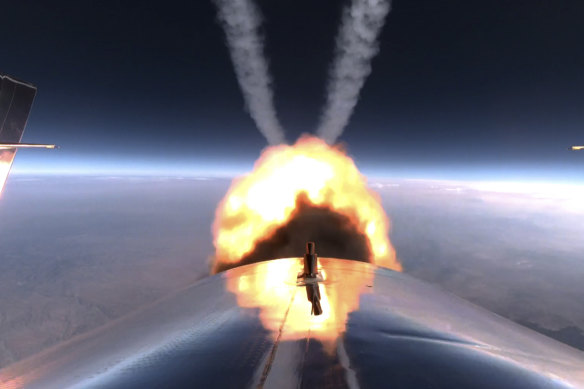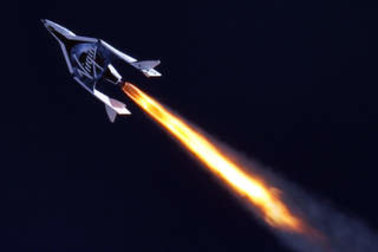By Rob Harris
London: Travellers would be able to fly from Britain to Australia in less than two hours within the next decade by travelling through space, new research from a major aviation body suggests.
The UK’s Civil Aviation Authority, which oversees and regulates aviation safety, funded a new medical study into the effects of suborbital space flights, where passengers would be briefly sent into space before descending to land at their destination.

In this photo provided by Virgin Galactic, the VSS Unity’s rocket motor burns above the Earth.Credit: AP
Suborbital flights, such as those offered by Sir Richard Branson’s Virgin Galactic, Elon Musk’s SpaceX, or and Jeff Bezos’s Blue Origin companies, currently cost more than $650,000 a seat. While so-called “A to B flights” differ from experimental space tourism, industry and regulators have forecast both forms of travel could become readily accessible by the mid-2030s.
A flight would involve a high G-force rocket launch to an altitude of up to 100 kilometres, where the craft would reach space but not have the required speed to stay in the Earth’s orbit.
The method of travel would mean journeys last only a fraction of the time taken by the current methods of aviation, with the flight time between the UK capital and Sydney usually around 22 hours or 19 hours direct from Perth or Darwin.
In 1985, a British Airways Concorde flight set a record for the London to Sydney leg in just 17 hours, three minutes and 45 seconds – with refuelling stops in Bahrain, Colombo and Perth.
The research, conducted with King’s College London and facilitated by the Royal Air Force, found that the majority of people handled the G-forces of suborbital space flights well.
Published in a peer-reviewed monthly journal, Aerospace Medicine and Human Performance, the study found older travellers could potentially be better at handling the journey than the young or super-fit.
Dr Ryan Anderton, the CAA’s medical lead for flight, told The Times that “physiological responses are likely to be benign for most passengers” but older people usually have slightly “stiffer arteries” which could lessen the pooling of blood away from the brain.
“For the vast majority of people, even older people, that’s not necessarily going to present a problem and there isn’t a detrimental effect long-term,” Anderton said.
“What we’re trying to do in research is determine which individuals might be more susceptible and what we might have to screen them for.”
The study placed 24 healthy people aged from 32 to 80 in an RAF centrifuge at Cranwell to recreate the G-forces felt during the launch and descent of suborbital rocket and spaceplane flights.
It found that G-forces could reach four times the usual force of the Earth’s gravity for 20 to 30 seconds during ascent and peak at six times, or 6G, during descent for 10 to 15 seconds.
These forces, the paper said, could create a heavy sensation on the chest, making it more difficult to breathe, and can reduce the intake of oxygen, affect the rhythm of the heart and lead blood to pool away from the brain.

Virgin Galactic is working on suborbital flights.
The study noted a rise in heart rate and blood pressure, a dip in blood oxygen and some “greying out” of peripheral vision during periods of high G-force, but found these quickly return to normal.
One participant briefly lost consciousness, but with no lasting ill effects. The effects were reduced when the chair was tilted back slightly.
Dr Ross Pollock, from King’s College London, said a suborbital traveller could lose consciousness during take-off and landing but would otherwise be fine during the flight.
“By changing the position of the chair you change the direction the G goes through the body. When the chair is upright, you get a lot of G-force going from the head to the feet,” he said.
“This in effect pushes the blood away from your head and eyes down towards your legs, therefore, you do not have enough oxygen reaching those parts of the body and your vision changes and potentially you can lose consciousness.”
Get a note directly from our foreign correspondents on what’s making headlines around the world. Sign up for the weekly What in the World newsletter here.